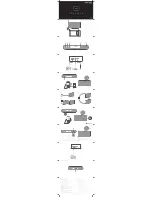
IS 25T - IS30T - IS34T
50 Hz
- 15
GB
GB
3. GENERATOR CARACTERISTIC
3.1 General caracteristic
The IS generators were designed for easy installation on
boats.
The soundproof casing, obtained with insulated, painted
marine aluminium panels, allows easy access to the
engine and the alternator for maintenance and inspection
operations, and at the same time strongly reduces noise.
The 4-stroke, direct-injection, diesel engine, built by Yanmar,
is extremely reliable and robust. Exhaust emission is in
conformity with CARB regulations.
The synchronous-type, 4-pole, brushless alternator has an
electronic voltage regulator (SR7) which guarantees stability
to + 5% with respect to the nominal value. The high pickup
capacity of the alternator makes the generator particularly
suitable for the power supply of electric motors of air
conditioners, desalination plants, compressors, etc.
The generator has a local control panel [Fig. 3 Ref. 4] on
which the controls and control instruments are housed.
3.2 Cooling system
The generator engine is cooled by closed-circuit circulation
of coolant which yields heat to the seawater by means of
a heat exchanger [Fig. 3, Ref. 26].
This heat exchanger was specially designed by
mase
to
make the engine suitable for use at sea.
A second heat exchanger cools the air inside the soundproof
casing and the air necessary for alternator ventilation.
At the time of installation a seawater feed circuit for cooling
must be installed and an exhaust system to convey the
combustion gas and the water used for cooling to the
outside, as indicate in the installation manual.
3.3 Control panel
A control panel is positioned on the generator for running
checks and to start and stop the generator. An engine
protection module [Fig. 4 Ref. 5] controls the generator
protections, stopping the engine in case of a fault and
signalling the fault detected by means of special warning
lights.
- Green RUN pilot light [Fig. 4 Ref. 6]
, when on,
indicates that the generator is running and no operating
fault has been detected.
- Red BATT pilot light [Fig. 4 Ref. 9)
, when on,
indicates that the alternator battery charger is faulty.
- Red OIL pilot light [Fig. 4 Ref. 7]
, when on, indicates
that the engine oil pressure is insufficient.
- Red "°C" [Fig. 4 Ref. 10]
pilot light, when on, indicates
that the temperature of the coolant or the water circulating
in the heat exchangers is too high.
- Red "°C" [Fig. 4 Ref. 8]
pilot light, when on, indicates
that the alternator windings have reached too high
temperatures.
- Yellow [Fig.4, Ref.11]
When on it signals that the pre-heating glow plugs have
been activated.
The glow plugs are turned on before starting by turning the
ignition key from the STOP to the ON position; once the
operating temperature has been reached, they
automatically go off and the engine can be started.
- Red [Fig.4, Ref.12]
When on it signals that the emergency stop button has
been pressed. Turn it to reset it.
The following may also be found on the control panel:
- A bipolar magnetothermal switch [Fig. 4 Ref. 2]
which cuts the power in case of an overload or short-
circuit.
- A thermal switch (Fig. 4 Ref. 3]
to protect the low-
voltage electric system against short-circuit.
- An hour counter (Fig. 4 Ref. 1].
- The generator start/stop button [Fig. 4 Ref. 4].
The generator can be connected with a connector to the
remote starting panel, [Fig. 3 Ref. 24] supplied by
mase
as
an optional, and can be installed on the dashboard.
Two different remote starting panels are available as shown
in Fig. 5.
The most simple version has a start/stop button [Fig. 5 Ref.
1] and a green pilot light [Fig. 5 Ref. 2] which, when on,
indicates that the generator is running.
The second version of the remote starting panel [Fig. 5 Ref.
3] has, in addition to the start/stop button, an instrument
which indicates the engine oil pressure value (Fig. 5 Ref. 4]
and an instrument which indicates the coolant temperature
value [Fig. 5, Ref. 5].
When carrying out maintenance
operations on the generator, disconnect the negative
pole of the starter battery to prevent accidental starting.











































